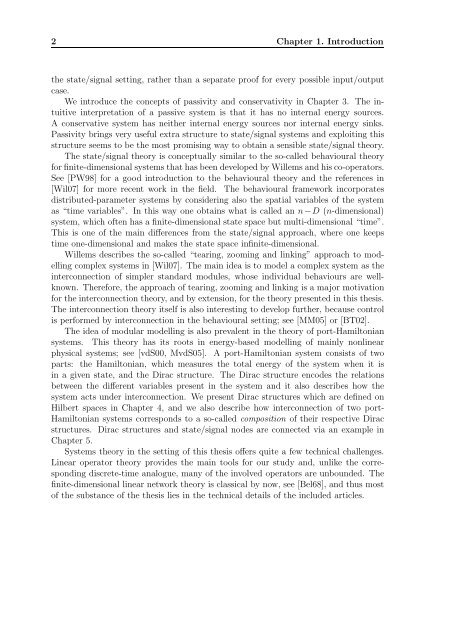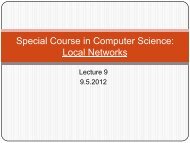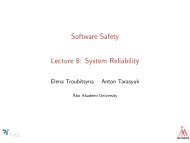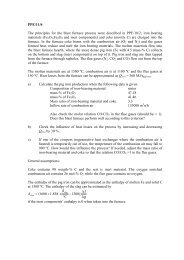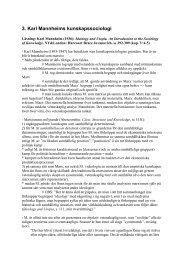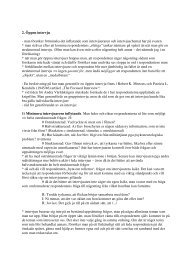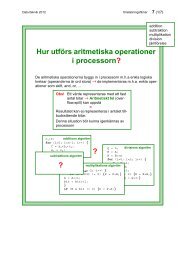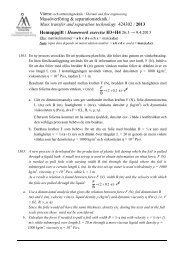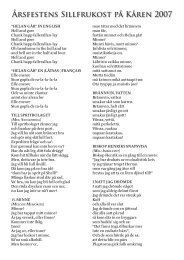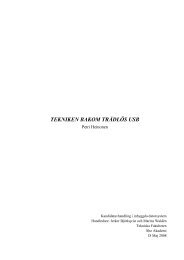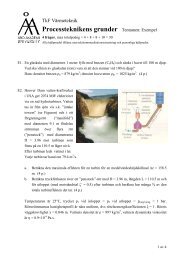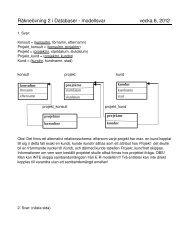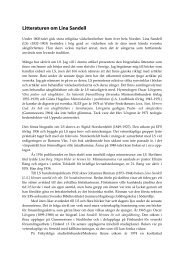Mikael Kurula - Åbo Akademi
Mikael Kurula - Åbo Akademi
Mikael Kurula - Åbo Akademi
You also want an ePaper? Increase the reach of your titles
YUMPU automatically turns print PDFs into web optimized ePapers that Google loves.
2 Chapter 1. Introduction<br />
the state/signal setting, rather than a separate proof for every possible input/output<br />
case.<br />
We introduce the concepts of passivity and conservativity in Chapter 3. The intuitive<br />
interpretation of a passive system is that it has no internal energy sources.<br />
A conservative system has neither internal energy sources nor internal energy sinks.<br />
Passivity brings very useful extra structure to state/signal systems and exploiting this<br />
structure seems to be the most promising way to obtain a sensible state/signal theory.<br />
The state/signal theory is conceptually similar to the so-called behavioural theory<br />
for finite-dimensional systems that has been developed by Willems and his co-operators.<br />
See [PW98] for a good introduction to the behavioural theory and the references in<br />
[Wil07] for more recent work in the field. The behavioural framework incorporates<br />
distributed-parameter systems by considering also the spatial variables of the system<br />
as “time variables”. In this way one obtains what is called an n−D (n-dimensional)<br />
system, which often has a finite-dimensional state space but multi-dimensional “time”.<br />
This is one of the main differences from the state/signal approach, where one keeps<br />
time one-dimensional and makes the state space infinite-dimensional.<br />
Willems describes the so-called “tearing, zooming and linking” approach to modelling<br />
complex systems in [Wil07]. The main idea is to model a complex system as the<br />
interconnection of simpler standard modules, whose individual behaviours are wellknown.<br />
Therefore, the approach of tearing, zooming and linking is a major motivation<br />
for the interconnection theory, and by extension, for the theory presented in this thesis.<br />
The interconnection theory itself is also interesting to develop further, because control<br />
is performed by interconnection in the behavioural setting; see [MM05] or [BT02].<br />
The idea of modular modelling is also prevalent in the theory of port-Hamiltonian<br />
systems. This theory has its roots in energy-based modelling of mainly nonlinear<br />
physical systems; see [vdS00, MvdS05]. A port-Hamiltonian system consists of two<br />
parts: the Hamiltonian, which measures the total energy of the system when it is<br />
in a given state, and the Dirac structure. The Dirac structure encodes the relations<br />
between the different variables present in the system and it also describes how the<br />
system acts under interconnection. We present Dirac structures which are defined on<br />
Hilbert spaces in Chapter 4, and we also describe how interconnection of two port-<br />
Hamiltonian systems corresponds to a so-called composition of their respective Dirac<br />
structures. Dirac structures and state/signal nodes are connected via an example in<br />
Chapter 5.<br />
Systems theory in the setting of this thesis offers quite a few technical challenges.<br />
Linear operator theory provides the main tools for our study and, unlike the corresponding<br />
discrete-time analogue, many of the involved operators are unbounded. The<br />
finite-dimensional linear network theory is classical by now, see [Bel68], and thus most<br />
of the substance of the thesis lies in the technical details of the included articles.


